
|
Sale 8
Coin and Currency Auction
| The "Heathgate" Collection of Flying Eagle and Indian Cents |
| |
| |
| Lot |
Photo |
Description |
Realized |
Lot 1074 |
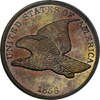 |
1856. Snow-5. Die pair. PCGS graded Proof 65. This is one of the most visually stunning 1856 Flying Eagle cent that could possibly exist. A sharp early die state example that is virtually mark free. Visually, there is no question of this coin's proof status. It has an absolutely full strike and is of the highest production quality witnessed on any 1856 Flying Eagle. This example is struck from the Snow 5 die pair, which was first described in 1992 in Rick Snow's book "Flying Eagle and Indian Cents". Only 10 examples of this die pair have been seen by this author, perhaps less than 35 examples of this die pair exist in all grades.
This die pair is a marriage of Obverse 2 and Reverse D as described in Snow. It is unlisted in Breen's die list found in Chapter XV of his Proof Encyclopedia. The obverse die is distinguished by a die chip at the base of the U in UNITED, called the "Pointed U". The reverse is a commonly encountered die, which is clearly identifiable by the large raised dot under the upper left serif of the N in ONE. This is a centering dot used by the engraver to fix one end of a protractor to draw circles on the unfinished die to center the wreath. The obverse die shows die striations visible in the field in three different directions. As the coin is rotated, striations in one direction become visible and then disappear as another set of striations appears. The reverse die has similar striations. These striations are found on all coins from this die pair.
To the uninitiated, die striations may be confused with hairline scratches. However, hairline scratches are grade-limiting problems caused by aggressive brushing or wiping of the coin after it has been struck. Die striations are polishing marks on the die, which are transferred to each coin until the die wears down enough to obliterate them. They do not affect the grade.
In the past there had been some confusion on the part of the grading services as to whether coins from this die pair are actually proofs or should be called Mint State because of the presence of these die striations. The first one identified and written up in Snow was unquestionably a proof. In the years that followed several more coins of the same die pair came to light, all exceptionally nice (possibly from the same unidentified source). This writer has seen coins from this die pair graded MS-63 (2 examples), PR-64, PR-65 (the present example), and MS-66 (Superior 6/5/2000:1003, $83,375) from PCGS, and a PR-65 from NGC. Recently PCGS has made it clear that they will only grade the Snow 5 die pair as a proof.
The commonly encountered proof 1856 Flying Eagles (Snow 9 die pair) are also struck using Reverse D, although in a later die state. These have been shown to be restrikes from the 1858 - 1860 "Snowdon" restriking period. (See Longacre's Ledger, Vol. 10.2, June, 2000, "Die states of the 1856 Flying Eagle Cent" By Richard Snow). The Snow 5 proofs are from the earliest die states seen from both dies. There is no way to accurately show exactly when the Snow 5 were struck, except to say that they were struck before all Snow 9 proof 1856 Flying Eagles, possibly even as early as 1857.
Here is an extremely beautiful 1856 Flying Eagle. One of the finest possible.
Collectors interested in joining the Fly-In Club, which publishes "Longacre's Ledger" may send $20 for a year's membership to: Fly-In Club, P.O. Box 13891, Reading, PA 19612.Back issues of "Longacre's Ledger" are also available.
Estimated Value $17,500 - 25,000.
Includes Eagle Eye Photo Seal.
View details and enlarged photos
| Realized
$29,325 |
Lot 1075 |
 |
1857. PCGS graded Proof 65. The example offered here shows a beautiful frosty Eagle over a deep mirror field. The black and white contrast gives this coin the look of an Eagle flying in clear moonless night sky. Proof Flying Eagle Cents are as beautiful as they are rare. The present example displays very few impairments. What initially may be thought to be hairline scratches are actually die polishing marks, which do not limit the grade. The reverse fields are equally deep mirrored. There are a few light hairlines and some flyspecking visible under magnification, but do not appreciably detract from the overall beauty of this piece. Presently only 8 examples are graded by PCGS in this grade with none higher.
Here is a real rarity in the proof cent series. An estimated 50 examples survive from 3 die pairs. The Red Book estimated mintage of 485 is either not based in fact or over 400 examples of this issue were destroyed or lost. Breen lists this issue as "less than 12 traced" and gives no estimated mintage. This estimate is a bit low, as Breen was only counting examples from one die pair, identified by the prominent die line which connects the I in UNITED to the denticles. The present coin is from that die pair. Rick Snow's "Flying Eagle and Indian Cent Attribution Guide" lists the die pair as PR-1. There are 3 die pairs known on this proof issue, however one of these (PR-3) also shows up on business strike issues, making attribution by die diagnostics alone tricky. The PR-1 die pair, offered here, and the PR-2 die pair come with their own credentials as no question proofs.
"Snow" variety can be found in Richard Snow's 1992 book, "Flying Eagle and Indian Cents", now out of print. A greatly expanded edition of the variety listing with additional "PR" proof die numbers is currently being issued in a 6 volume set, "The Flying Eagle and Indian Cent Attribution Guide". These can be ordered through Eagle Eye Rare Coins, P.O. Box 65645, Tucson, AZ 85728, or at WWW.INDIANCENT.COM.
Estimated Value $22,500-UP.
Includes Eagle Eye Photo Seal.
View details and enlarged photos
| Realized
$27,600 |
Lot 1076 |
|
1858. Pattern Cent. Small Letter Flying Eagle. J-193. . J-193. PCGS graded Proof 65. Oak Wreath with Broad Ornamented shield. A very attractive example with a deeply mirrored obverse and moderately mirrored reverse. This is one of the popular 12 piece sets of 1858 pattern cents which were sold by the Mint. The sets were struck in quantities probably approaching 75 sets. Many of the surviving examples are dull and lifeless. This coin is wonderful exception.
The obverse die exhibits a "Broken U" in UNITED, where the inner serif of the letter is missing. This is a hub variety, which could exist on any number of dies. Only a very small number of examples of the J-193 were struck using this obverse die, probably no more than 25. The reverse features an Oak wreath with a wide ornamented shield.
Volume 1 of Rick Snow's "Flying Eagle and Indian cent Attribution Guide", 2nd edition will feature all known Flying Eagle varieties and will also contain the most complete research on the 1858 pattern cents. It is expected to be available in the spring of 2001.
Estimated Value $2,500 - 3,500.
Includes Eagle Eye Photo Seal.
View details
| Realized
$3,450 |
Lot 1077 |
|
1858. Pattern Cent. Large Letter Flying Eagle. J-198. . J-198. PCGS graded Proof 65. Oak Wreath with Broad Ornamented shield. The present example is essentially flawless piece with moderate mirrors. The coin exhibits a light golden toning. This is probably the finest extant example. Currently there are only 3 coins graded at this level with none graded higher.
All Large Letter 1858 patterns are much rarer than their Small Letter counterparts. It is estimated that only 12 to 20 sets were made with this obverse style. It is probable that the distinction between Large Letter and Small Letter dies was not deemed important at the time of striking. By studying the die states of the reverse, we can tell that these were struck prior to the Small letter patterns. The present example is struck with early die states of both dies.
Estimated Value $3,000 - 4,000.
Includes Eagle Eye Photo Seal.
View details
| Realized
$4,140 |
Lot 1078 |
|
1858. Pattern Cent. J-208. . J-208. PCGS graded Proof 65. Head with broad bust point / laurel (olive) wreath with 5 leaf clusters. A gorgeous example with deep mirrors and outstanding eye appeal. Very unusual for this issue, which is typically seen rather dull with moderate mirrors. This is certainly one of the most attractive examples of this issue.
This is a popular quasi-transitional pattern with the 1858 date and the Indian head design first used in 1859. This is, however a slightly different designs than the adopted design, most notably in the difference in the bust truncation. The adopted 1859 style has a narrower truncation. The reverse is also slightly different from that adopted in 1859; with the adopted version having 6 leaves in the wreath. True transitional 1858 patterns do exist, but they from a very limited striking from 1859 or later.
Because of its popularity at the time of striking, this issue was struck in much higher numbers than the other 1858 patterns, probably as many as 300 pieces.
Estimated Value $2,500 - 3,500.
Includes Eagle Eye Photo Seal.
View details
| Realized
$4,370 |
Lot 1079 |
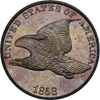 |
1858 Flying Eagle Cent. Large letters. PCGS graded Proof 65. A fabulous deep mirror cameo example with frosty devices. A contact mark in the field between STATES and the eagle is the only mentionable impairment, but is easily overshadowed by the extremely beautiful eye appeal.
This, like all Flying Eagle cents, is very rare in proof format. A mintage of 80 is given in various pricing guides. This number represents the best guess of numismatists in the past and may be close to the number of survivors, not the original mintage. Barring the discovery of official Mint records, a good guess at the original mintage could be closer to 200. Regardless, this is a rare coin and should garner considerable competition.
The PCGS populations are slightly skewed due to the addition of the Large Letter listing in the early 1990's. Early population reports combined both Large Letter and Small Letter proofs into one figure. When the two were divided, all previously submitted 1858's were listed as the Small Letter. Both populations are small, so in the intervening years additional submissions and regrades have slowly made the listing slightly useful. Less than 20 examples of both styles have been graded by PCGS.
Only one die pair has been seen for this issue. The obverse is easily identified by two small die file marks extending from the denticles below the first 8. This die was also used for the 1858 Patterns featuring the Large Letter flying eagle obverse. The reverse die is identified by a microscopic die file mark extending from the denticles at 11:30. This die is found on a few examples paired with the Small Letter obverse.
Die diagnostics for this issue are important, as there is a group of about 20 or so high grade examples with highly prooflike fields. The prooflike examples can be deceiving except that they mostly all have a die crack by the eagles tail, an attribute that in itself should make their attribution as non-proofs easy.
Estimated Value $12,500 - 20,000.
Includes Eagle Eye Photo Seal.
View details and enlarged photos
| Realized
$18,975 |
Lot 1080 |
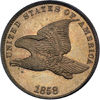 |
1858 Flying Eagle Cent. Small letters. PCGS graded Proof 64. A very attractive example of this rare issue. High leaf reverse. A light mark above the date and scattered hairlines on the obverse and a contact mark on the reverse above the O in ONE serve to lower the grade out of the gem category. Still, this coin is a stunning example for the grade.
The mintage of 200 given in many catalogs seems is probably the upper range of the real mintage, with 100 being a more appropriate guess. Estimates of survivors based on auction records are a bit too high because of the addition of prooflike examples that were most likely issued in one of the issues of the 1858 Pattern sets (Eliasberg 5/96:609 is but one example). The PCGS population report also gives too generous a number of pieces graded. All 1858 Flying Eagles graded before the early 1990's were lumped into one listing which, when separated, became the Small Letter population. The number extant of no question Small Letter proofs is on the order of a total 75 examples, closer to the rarity of the 1857 issue than the 1858 Large letter.
The present example carries the "High Leaf " reverse, with the leaves by the C & T in CENT long, extending slightly above the base of the letters. This is the same die as used in conjunction with the Large Letter obverse, although in a later die state. Small Letter Proofs come with both "High Leaf" and "Low Leaf" reverses. The examples issued in the pattern sets all used the "Low leaf" reverse designs, which is a redesign made at some point in the middle of the production this year to lower the relief of the reverse die.
The Small Letter design is a redesign made in mid-year and is actually a type unto itself. The most obvious change are the smaller letters, but the eagle is also sports a slight modification. It is possible that this change was made to promote an extended die life, as with the reverse redesign.
Estimated Value $8,000 - 12,000.
Includes Eagle Eye Photo Seal.
View details and enlarged photos
| Realized
$12,075 |
Lot 1081 |
|
1858 Flying Eagle Cent. Small letters. PCGS graded MS-65. This example is a beautiful fully struck gem with dazzling eye appeal. Mostly brilliant with a light golden toning. Some minor contact marks are present, but these do not detract from the look of the coin. Some light doubling visible on the date and right side of the coin is caused by strike doubling, a typical occurrence on the 1858 Small Letter cents.
The Mintage of 1858 Flying Eagles is divided fairly evenly between Large Letter and Small Letter types. The Small Letter design is a new style, one might say it's the style of 1858, whereas the Large Letters type could be called the style of 1857. In addition to the letters being smaller, the eagle was slightly redesigned as well. This is a whole separate design type, not just a minor modification.
In 1858 the reverses were redesigned as well. The style used in 1857 and early 1858 had a bolder wreath and denomination. The new style (seen on this example) has a shallower wreath and denomination. This is called "Low leaves" due to the length of the leaves inside the wreath below the C & T. The 1857 style, called "High leaves" has higher leaves in these positions.
Estimated Value $2,500 - 3,500.
Includes Eagle Eye Photo Seal.
View details
| Realized
$3,910 |
Lot 1082 |
|
1858. 8 over 7. PCGS graded MS-64. One of the finest examples of this very popular overdate. One must look carefully to find any imperfections. This coin has an even light brown tone. A small darker area between the wing and the I in UNITED appears to be merely surface dirt. This coin has all the look of a higher grade.
The strike is as full as this issue is seen. There is slight weakness on the upper right quadrant of the reverse, but this is how this issue comes. No 1858/7 has been seen with any more detail in this area than this coin. For the longest time there has been resistance on the part of the grading services to grade any 1858/7 a MS65. This may be because of the weakness on the reverse. Since this weakness is on all coins from these dies, should it be a factor in limiting the grade?
This is a very early die state. The 7 digit shows very clearly above and to the right of the last 8. The diagnostic die dot above the date is bold and triangular in shape. The broken wing tip is just about connected to the wing, this being another indication that this is indeed a very early die state. There are light die striations visible diagonally from the lower left to the upper right of the coin. Additional die file marks are visible under the date. These features are only visible on the earliest of die states.
The die states of this issue are very important because nearly 75% of the entire issue is from late state dies with no evidence of the 7 showing. Collectors who desire top quality examples of this date demand to see the 7! The aforementioned die chip is actually the left base of a misplaced 1 digit! Only on these early die state pieces is this feature clearly from a digit punch.
This is a huge opportunity to acquire on of the finest examples of this popular overdate. This issue is normally collected as part of the regular issue Flying Eagle series, adding to its desirability.
Estimated Value $8,000 - 12,000.
Includes Eagle Eye Photo Seal.
View details
| Realized
$23,000 |
Lot 1083 |
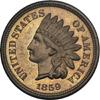 |
1859 Indian Head Cent. PCGS graded Proof 66. An outstanding deep mirror example with exquisite surfaces and wonderful eye appeal. Essentially perfect as per the qualifications for the grade. Popular and important as a one year type design featuring Longacre's Indian head design and a simple reverse design featuring a Laurel wreath reverse around the denomination, "ONE CENT". However, the obverse portrait is actually "Lady Liberty", a Caucasian representation of Liberty borrowed from the Three Dollar design of 1854. She is wearing a headdress of a Native American of the Chippewa tribe. The reverse is actually an olive wreath, although the laurel wreath description is somewhat accurate as their leaves are visually similar.
Estimated Value $8,000 - 12,000.
Includes Eagle Eye Photo Seal.
View details and enlarged photos
| Realized
$7,475 |
Lot 1084 |
|
1859 Indian Head Cent. NGC graded MS-65. A very rare and dramatic repunched date, one of the top varieties in the entire Indian Cent series. All four digits are plainly visible repunched to the southwest. This is the finest known example, the only MS-65 known. The current condition census, by Jerry Wysong of the Fly-In Club, shows this MS65, a MS64 and one in the MS-60-62 range, the rest of the 26 reported examples being circulated to some extent. The Cherrypicker's Guide, by J.T. Stanton and Bill Fivaz prices this coin at $10,000. This price is many years old and represents the last wholesale transaction of this coin.
This coin is fully struck with outstanding luster. There are no major marks to speak of. A few light scattered contact marks are seen, but these do not detract from the overall beauty of the coin.
The collecting of Indian cent varieties is still very much in its infancy. Top examples of the most popular varieties are finding enormous demand.
Estimated Value $7,000 - 10,000.
Includes Eagle Eye Photo Seal.
View details
| Realized
$12,075 |
Lot 1085 |
 |
1860 Indian Head Cent. PCGS graded Proof 65. A visually appealing example with moderate mirrors and exceptional eye appeal. The surfaces are free of any contact marks. The coin exhibits a beautiful light golden tone. The first year of the series featuring the Lady Liberty in a Native American headdress paired with the new reverse featuring a wreath of oak with a sprig of olive and three arrows knotted at the base with a ribbon. The federal shield of the Union is featured above the wreath. This design is continued until the end of the series, with minor modifications along the way.
This is a very tough date to find in full gem condition. The majority of the estimated mintage of 542 was struck only once, imparting an impression that usually did not strike out all of the planchet marks. The quality of the 1860 issue is always somewhat lacking in the quality seen up to 1859 and after 1861. They are nearly always seen with mirrors that are only moderate and edges that are rounded, which is why these are sometimes confused as being prooflike strikings. The population figures bear this out with only 19 examples presently graded with 2 better by PCGS.
In early 1860 the portrait was redesigned significantly for some unknown reason. The main difference in the two designs is the shape of the bust truncation. The type of 1859 has a short pointed bust truncation. The type adopted in 1860 has a more rounded bust point. All proofs are struck from the rounded bust design.
Estimated Value $3,000 - 4,500.
Includes Eagle Eye Photo Seal.
View details and enlarged photos
| Realized
$4,370 |
Lot 1086 |
|
1860 Indian Head Cent. Pointed bust. PCGS graded MS-65. A beautiful example with a great strike and soft satiny cartwheel luster. A very scarce date and one of the finest known. Until the early 1990's this as considered a very rare variety, and was listed in Breen's Encyclopedia as such. The reality is, however that this is really a separate entry into the regular date set of Indian Cents. It is as dramatic and different a design as the 1864 With L is from the 1864 No L type. Starting in 1994, this type was included in the "Guide book of United States Coins" - The Red Book. Since then collectors have started including this coin in their sets, many of which were previously thought to be complete.
The "Pointed Bust" style refers to the narrower bust truncation as used in 1859. One may label this as the "type of 1859". The redesign to the broad bust point in 1860 seems to have come early in the year. Perhaps the 6 known obverse dies that struck the 1860 pointed busts were undated dies leftover from 1859. In any event the coin was struck in large enough quantities to satisfy most collectors demand, but a small enough quantity to make it one of the key dates of the series. The estimated original mintage is about 1/2 million to 1 million pieces, making it about between 20 to 40 times rarer than the broad bust point pieces.
Estimated Value $5,000 - 7,000.
Includes Eagle Eye Photo Seal.
View details
| Realized
$6,325 |
Lot 1087 |
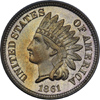 |
1861 Indian Head Cent. PCGS graded Proof 66. A beautiful example with frosty devices and moderately deep mirror fields. A few contact marks are visible on the reverse on the N and E on ONE. Nevertheless, this is an outstanding example of this exceptionally tough date. As with the 1860 issue, many coins struck this year were struck only once on moderately mirrored dies. This lack of quality standards at the Mint has made this a real tough issue to locate in gem condition. Out on an original mintage of 1000 pieces, only about 400 were released. The survivor rate seems to be quite low, perhaps many substandard examples were subsequently spent, or included collections as non-proofs.
There is enormous collector demand for this issue in gem condition. Expect fierce competition for this beauty.
Estimated Value $7,500 - 12,500.
Includes Eagle Eye Photo Seal.
View details and enlarged photos
| Realized
$19,550 |
Lot 1088 |
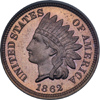 |
1862 Indian Head Cent. PCGS graded Proof 65. A beautiful example with flawless surfaces and moderate mirrors. This is the "type" date in the copper-nickel Indian Cent series. Usually available much more often than any other date from 1860 to 1864, even though the mintage of 550 is not substantially higher. This issue is found much better than 1860 and 1861. In addition to higher quality standards at the Mint, there was a substantial hoard of approximately 200 coins, which came to light many years ago.
Estimated Value $1,750 - 2,500.
Includes Eagle Eye Photo Seal.
View details and enlarged photos
| Realized
$2,530 |
Lot 1089 |
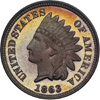 |
1863 Indian Head Cent. PCGS graded Proof 66. A stunning deep mirror cameo gem! A touch of golden toning is visible on the obverse. This is an outstanding opportunity to acquire a high end example of a copper nickel Indian Cent. Only 6 example are currently graded by PCGS with one better.
Nearly the entire issue of 460 pieces was struck from a single set of dies. Later in the year a new set of regular proof dies were made to strike the bronze pattern issue, J-299 to test the feasibility of changing the composition of the cent from copper-nickel to bronze. About 100 bronze 1863 cents were struck with some examples sent to Treasury Secretary Salmon P. Chase on December 8th, 1863. This coin is struck with these same dies after this pattern press run. This coin is of course not a pattern, as it is struck on a copper-nickel planchet. It is interesting that it can be linked to the pattern issue. This is the only copper-nickel example from these dies that has been identified.
The die diagnostics for nearly all proofs of 1863 (PR-1) is unpolished centers in the final A in AMERICA. This example and the J-299 proofs show the center of the final A in AMERICA polished, with the lower loops of the 8 & 6 unpolished (PR-2).
Estimated Value $3,000 - 5,000.
Includes Eagle Eye Photo Seal.
View details and enlarged photos
| Realized
$5,060 |
Lot 1090 |
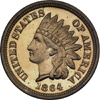 |
1864 Indian Head Cent. Copper-nickel. PCGS graded Proof 66. A beautiful ultra-deep mirror example with fully frosted devices. Nearly perfect, the sole exception being a few light flyspecks, which are visible with high magnification. The reported mintage of 370 pieces is the lowest of all the copper-nickel Indian Cents. Survivors are typically below average compared to the quality of the 1862 issue. This example is one of the notable exceptions. Except spirited bidding on this gem. The reverse is slightly rotated to the left.
Estimated Value $3,500 - 5,000.
Includes Eagle Eye Photo Seal.
View details and enlarged photos
| Realized
$4,830 |
Lot 1091 |
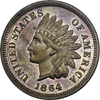 |
1864 Indian Head Cent. Copper-nickel. PCGS graded Proof 64. The rare 1864 with L proof, struck in copper nickel. Only 3 examples are known to exist. This coin, another PR-64 PCGS example which is in an upstate New York collection, and an XF example rumored to exist. This example exhibits moderately deep mirrors, frosty devices and nearly flawless surfaces. Only a few insignificant contact marks limit the grade.
This is actually a transitional issue, which could easily be argued to be an essential part of a complete collection of Indian Cents -- an extension of the copper-nickel series into the design change to the "With L" redesign by James Longacre. Although the addition of the designers initial to the lower ribbon is part of the design change, the whole portrait was given a much needed redesign. The feather headdress is now much sharper, as is the hair detail. The bust truncation is now very narrow, very similar to the 1859 and 1860 pointed bust issues.
The dies used to strike this issue are the same dies that struck the 10 known original 1864 with L proofs in bronze (PR-1). The reverse die was also used on the 1864 No L proofs, confirming that this coin was indeed struck in 1864. It now is widely known that the other half of the 20 known 1864-L bronze proofs (PR-2) were struck during the "Linderman" restriking period of 1868-71. Proof of this came when this author compared an 1864-L with later proofs from 1870 and 1871 and found the reverses to be identical. Who said reverse dies are boring!
We can only speculate about the reason this coin exists. Perhaps Longacre planned a redesign of the Indian Cent in 1864 independent of the decision to change the composition to bronze following the passage of the Mint Act of April 22, 1864. If so, then the 1st issue of bronze 1864 With L's would also have been struck before that date, making them patterns as well. By comparing the die polishing marks on the reverse of this coin with the next lot, the 1864 No L proof issue was struck first. This shows that in all likelihood the proof 1864 With L's in both copper-nickel and bronze were indeed struck late in the year after the changeover to bronze was official, which is why this coin gets the pattern number and the bronze 1864 with L's do not.
The rarity and importance of this coin is tremendous. This coin has not been available in a public auction for many, many years, if at all. In fact, when this coin surfaced in the 1990's, it resided in a major third party encapsulation without any indication as to its importance. The coin had labeled as a regular 1864 CN proof! Of course, it is the coin that is important, not the label, and this coin was never in doubt as to its real status as the nearly unique 1864 With L Proof in copper nickel.
Estimated Value $10,000-UP.
Includes Eagle Eye Photo Seal.
View details and enlarged photos
| Realized
$17,250 |
Lot 1092 |
 |
1864. Bronze, no "L". PCGS graded Proof 66 Red. A very important coin as a one-year type, the type of 1860 - 1864 struck in the new bronze alloy. This example had until recently been tied with one other example as the finest graded by PCGS. The coin has outstanding deep mirrors with frosted devices and essentially perfect surfaces. The coin has acquired a beautiful golden color with the passage of time. This is one of the rarest dates in the proof Indian Cent collection.
The mintage of 1864 proof cents is open to some debate. Breen recorded a total of 470 proof sets of the silver and minor coins sold by the Mint. He breaks down the deliveries to those made before the Mint Act of April 22 as the mintage of the copper nickel examples (370) and those after as the mintage of the bronze No L pieces (100). This cannot be correct, since there are nearly 200 1864 No L proofs graded from all the grading services combined. There must have been an unknown number of specimens made and distributed later in the year. Up until this time, and continuing until 1878, the mintage figures of minor coins must be reconstructed from sales figures of sets and any other collateral evidence that can be found. The Mint was under no legal obligation to record mintage figures for minor coin proofs. We can guess at the original figures based on what we see in the marketplace, accounting for a quantity of examples being lost to the ravages of time, but even an educated guess will undoubtedly be off the mark. Regardless, perhaps 300 is the correct mintage.
Estimated Value $20,000-UP.
Includes Eagle Eye Photo Seal.
View details and enlarged photo
| Realized
$18,400 |
Lot 1093 |
|
1864 Indian Head Cent. Bronze, with "L". PCGS graded MS-65 Red. A fabulous example with a full strike and outstanding eye appeal. Nearly flawless surfaces. Typically, the dies used to strike the issues this year were used until they literally fell apart. Finding a gem with surfaces as clean as this coin is quite a task. This is one of the most beautiful 1864 With L's there is. It certainly looks better than the typical a MS65RD.
The 1864 With L design is a modification made presumably late in the year. With an estimated mintage of about 5 million, this is one of the key dates in the series. This new design with Chief Engraver James B. Longacre's initial "L" on the lower ribbon. All issues after this year have this feature. The portrait was also redesigned, changing back to a narrow bust point style used for the 1859 and 1860 pointed bust issues.
Estimated Value $2,500 - 3,500.
Includes Eagle Eye Photo Seal.
View details
| Realized
$4,140 |
Lot 1094 |
 |
1865 Indian Head Cent. PCGS graded Proof 65 Red. An outstanding deep mirror cameo gem with spectacular eye appeal. The surfaces are virtually flawless and except for one small spot on the obverse in the field below the portrait, border on perfection.
This is a very difficult date to find in gem full red. Like many other dates in this series, the rarity of the coins struck in proof format have no relation to the rarity of the regular issues. Non-proofs are fairly common for this date. Not so for the proofs. The mintage currently given in references is 500, which may be generous.
This issue is notorious for having low percentage of red. Many of the planchets used for the proofs were on streaky planchets. When the alloys of Tin and Zinc are not mixed well into the copper, pockets of alloy remain in the bronze ingot. As the ingot is rolled out, these pockets get elongated and eventually turn into streaks on the finished planchets. Tin and Zinc are very volatile and will not hold the original color of the coin. The few 1865's that remain in full red are presumably from a higher quality melt, and are very rare and desirable because of this.
Estimated Value $6,000 - 9,000.
Includes Eagle Eye Photo Seal.
View details and enlarged photos
| Realized
$6,038 |
Lot 1095 |
|
1865 Indian Head Cent. PCGS graded MS-66 Red. Two commonly collected date styles exist for this year. The Plain 5, which was used to strike both business strikes and proofs and the Fancy 5, offered here. The difference is obvious by comparison. The Fancy 5 has a squared top with a spoon shaped end. The Fancy 5 does not exist struck in proof format.
This coin is an outstanding example with a full strike and great luster. Certainly one of the finest known. In October of last year, PCGS decided to divide the 1865 submissions into the Plain 5 and Fancy 5 designations. Their population figures will be inaccurate reflection of the comparative rarity between the two date styles. Overall the Plain 5 is just slightly scarcer of the two.
Estimated Value $2,500 - 3,500.
Includes Eagle Eye Photo Seal.
View details
| Realized
$3,450 |
Lot 1096 |
|
1865 Indian Head Cent. PCGS graded MS-65 Red. Flaming bright red on both sides and well struck. Traces of an old fingerprint in the left obverse field and some spotting on the lower reverse. Seldom found in full Red condition.
Estimated Value $1,000 - 1,500.
Includes Eagle Eye Photo Seal.
View details
| Realized
$2,415 |
Lot 1097 |
|
1865 Indian Head Cent. ANACS graded AU-58. This is a very rare and dramatic doubled die. The entire reverse is dramatically shifted to the left. The present condition census lists 6 coins grading MS and 3 in AU grade with 22 examples reported. This is a really rare coin. The coin is very nearly uncirculated with a trace of red still evident. No major marks are visible. The Cherry Picker's Guide lists the price for AU's at $1,700 and MS-60's at $2,500. The values are low due to the lack of coins being traded. This variety was unlisted in Breen.
Estimated Value $2,500 - 3,500.
View details
| Realized
$2,070 |
Lot 1098 |
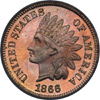 |
1866 Indian Head Cent. PCGS graded Proof 65 Red. Visually stunning! Deep, deep mirror cameo gem with fully frosted devices. A few flyspecks are visible under magnification and keep the grade of this coin from something closer to total perfection. Closer inspection will reveal small depressions on Liberty's cheek and neck. These are presumably die rust marks and are on every example and are therefore not considered in determining the grade of any 1866 proof. The reverse die is the same die used on the previous lot, the 1865, although it was repolished between the two issues.
Estimated Value $4,000 - 6,000.
View details and enlarged photos
| Realized
$6,613 |
Lot 1099 |
|
1866 Indian Head Cent. NGC graded MS-66 Brown. The Finest Known! This is essentially a flawless coin. Although graded 66BN, it does have about 10% red remaining. This is one of the top varieties in the entire Indian Cent series. This variety exhibits bold doubling on the portrait visible most on the LIBERTY. It also has the base of a 1 digit boldly visible in the third and fourth pearl on the necklace. There are also the tops of three 6's visible in the denticles below the first 6 in the date. Only seven MS examples are presently reported, with three being MS-64 and one MS-65. Thirty-nine are reported in all grades. This is a very rare and popular variety.
Last reported sales for this variety are all about 4 years old when a PCGS MS64BN sold for $2,400, the sole NGC MS-65RB sold for $5,000. The last sale price noted for this coin was $7,500. Considering the rarity and popularity of this variety and the growth of Indian Cent variety collecting, these values seem relatively cheap.
Estimated Value $5,000-UP.
Includes Eagle Eye Photo Seal.
View details
| Realized
$4,140 |
Lot 1100 |
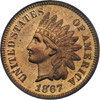 |
1867 Indian Head Cent. PCGS graded Proof 65 Red. A beautiful deep mirror cameo gem. This is an exceptional example for this date. Except for a few light flyspecks the coin is virtually as struck. The dies used for proofs this year show many anomalies, which sometimes get mistaken for problems on the coin. On the obverse there is always a die line on the neck, which to the uninitiated eye may look like a scratch. The reverse die is a leftover die used in 1865 and 1866. By its usage in 1867 it has acquired numerous die polishing marks which may look like hairlines. None of these are grade limiting and are on all examples seen to date.
Estimated Value $4,000 - 6,000.
Includes Eagle Eye Photo Seal.
View details and enlarged photos
| Realized
$5,290 |
Lot 1101 |
|
1867 Indian Head Cent. PCGS graded MS-65 Red and Brown. This is one of the top repunched dates in the series, one of the few that are collected as part of the regular date set. The 6 & 7 are repunched boldly above the date. This example is one of the top examples known. The surfaces are virtually perfect. The strike is full and the eye appeal is wonderful. Only 2 examples are known in full red (MS-64RD) and only 5 examples are reported in MS65RB. One MS66RB is known. The Cherry Picker's guide prices this variety at $2,500 in this grade.
Curiously, this variety is always seen with a late die state obverse, with numerous clash marks and roughness in the fields. It is probably that the repunching on the date was done after the die was used for an extended period. The problem with this scenario is that the die would be too hard to accept the new repunching. However, the die could have been softened, accounting for the buckling and surface roughness. Later die states of this variety actually show a smoother field due to additional repunching. A very interesting variety.
Estimated Value $1,500 - 2,000.
Includes Eagle Eye Photo Seal.
View details
| Realized
$2,070 |
Lot 1102 |
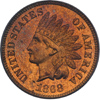 |
1868 Indian Head Cent. PCGS graded Proof 65 Red. Another beautiful gem with moderately deep mirrors and frosty devices. The coin has acquired a distinctive "Old Gold" look. A bit redder than the bright gold typically seen. This example is one of the 100 or so examples struck with a widely rotate reverse (about 170 degrees). A very interesting piece. Examples of this date are very hard to locate in gem condition. Presently only 8 are graded by PCGS with 2 better.
Estimated Value $4,000 - 6,000.
Includes Eagle Eye Photo Seal.
View details and enlarged photos
| Realized
$7,188 |
Lot 1103 |
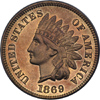 |
1869 Indian Head Cent. PCGS graded Proof 66 Red. A stunning moderately deep mirror gem with a beautiful cameo contrast. Only a couple light contact marks hidden in the portrait keep this coin from a higher level. Many die polishing lines in the field may be mistaken for hairlines.
Many of the dates in the late 1860's and early 1870's are only found with moderately deep mirrors. The reason for this seems to be that the dies had been polished after they were hardened, which does not impart as deep a mirror as found on later dates. Additionally the reverse dies were normally held over and used for many years, being repolished many times throughout its life.
Estimated Value $5,000 - 7,000.
Includes Eagle Eye Photo Seal.
View details and enlarged photos
| Realized
$7,188 |
Lot 1104 |
|
1869 Indian Head Cent. NGC graded MS-66 Red and Brown. Fully struck with essentially flawless surfaces. This is a nearly full red example. This is one of the bolder repunched dates in the series. It is commonly collected in the regular date set.
There are many repunched dates known for this year, none of which have any clear claim to being the overdate - 1869/8. The 1869/8 overdate was discovered by Walter Breen in 1953 and widely publicized by dealers. Overdates like the 1858/7 and 1888/7 have always been included in the basic date set, increasing their demand in the process. In the late 1980's numismatists at the ANA showed that any real 1869/8 overdate should have dramatic repunching visible on the flag of the 1 as well. The reason is that the 1868 digit punch has a very different shape to the 1 than the 1869 issues. Old habits die hard, and collectors still search for the very elusive 1869/8.
Estimated Value $2,000 - 3,000.
Includes Eagle Eye Photo Seal.
View details
| Realized
$2,645 |
Lot 1105 |
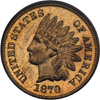 |
1870 Indian Head Cent. PCGS graded Proof 65 Red. A moderately deep mirror gem. There are very few grade limiting marks on this coin. However, as is seen on all 1870 proof Indian Cents, the dies are rather roughly polished on both sides. The resulting crisscrossing die polishing marks may be confused with hairlines on the field of the coin. The reverse die used to strike this example is the same die that struck some of the 1864 With L proofs (PR-2).
Estimated Value $2,000 - 3,000.
Includes Eagle Eye Photo Seal.
View details and enlarged photos
| Realized
$2,645 |
Lot 1106 |
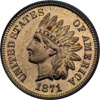 |
1871 Indian Head Cent. PCGS graded Proof 65 Red. An outstanding example of this date. Stunning eye appeal. Virtually perfect surfaces. All 1871 Indian Cents come with moderate mirrors, and this coin is no exception. The beauty of this example is magnified when you realize how the typical 1871 looks. As in the previous lot, the apparent hairlines on the fields are actually die polish lines imparted at the Mint. These do not limit the grade, however they may have influenced the graders to be a bit too conservative on this example. A wonderful example. The reverse die used on this example is the same as used in 1870. This is a shallow N reverse, which was the old style used prior to this date. Most 1871 non-proof Indian Cents have the new redesigned reverse which has a bold N in "ONE".
Estimated Value $2,000 - 3,000.
Includes Eagle Eye Photo Seal.
View details and enlarged photos
| Realized
$2,415 |
Lot 1107 |
 |
1872 Indian Head Cent. PCGS graded Proof 65 Red. A beautiful cameo gem example. Moderate mirrors, as deep as ever seen for this date. This die exhibits light die polishing lines that may look like hairlines at first glance. There are a few Mint made lint strike-throughs, but these are mostly hidden and don't detract from the coin's beauty. These are made when the coin is struck and do not affect the grade at this level. In fact, there is nothing on this coin which should limit the grade to only a PR-65RD.
The 1872 proof issue was struck in about the same quantities as the other dates in the early 1870's, but for some reason, are much scarcer than other dates in gem full red grades. Most of the encountered examples are some shade of red brown. There is strong additional date demand for this issue due to the rarity of the non-proof format issues.
The reverse die used on this coin has a curios anomaly. There is a distinct bulge on the right serif of the T in CENT. This die is seen on later issues until 1877.
Estimated Value $4,000 - 6,000.
Includes Eagle Eye Photo Seal.
View details and enlarged photos
| Realized
$6,325 |
Lot 1108 |
|
1873 Indian Head Cent. PCGS graded Proof 65 Red. An attractive coin with nearly flawless surfaces. An outstanding coin for this issue which typically comes with moderate mirrors. The obverse fields has been drastically polished to the point where the eye socket is now part of the field and the first feather is disconnected from the headband. Nearly all 1873 proofs seen to date are like this. The reverse die is a reuse of a die first used for the 1872 proof.
The Closed 3 date style is used on the early dies made prior to Chief Coiner A.L. Snowden's complaint on January 18th regarding the similarities of the look of the date to 1878. All proofs this year are of the closed 3 style. The reported mintage of 1100 seems to be in line with the rarity of examples seen in the marketplace. This is a very tough coin to locate in gem full red condition. This is due to the sloppy die preparation, which produced coins that do not seem to excite very often. As a result only 18 coins are graded by PCGS in PR65RD with 2 better.
Estimated Value $2,000 - 3,000.
Includes Eagle Eye Photo Seal.
View details
| Realized
$3,335 |
Lot 1109 |
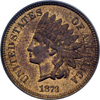 |
1873. Doubled "LIBERTY". Snow-1. PCGS graded MS-65 Red and Brown. This is the finest known example of the King of the Indian Cents. This coin has never been on the market before this sale. It was originally purchased uncertified by Eagle Eye Rare Coins in 1996, sold to a California collector, repurchased again 6 months later and placed into the "Heathgate" collection. It exhibits 85% red color and tremendous luster. It is fully struck with nearly perfect surfaces. This is an early die state example with every strand of hair standing out with clear crisp detail. There is slight browning on the high points and in the field to the right of the portrait on the obverse and on the lower right half of the reverse. A small tick is visible on the O in ONE.
Presently only 122 examples of the 1873 Double LIBERTY are reported, mostly in lower grades, as reported by Jerry Wysong in his population study in "Longacre's Ledger". Three examples are known in MS-65RB. The second finest is a close twin to this example, although with a bit less red, and is graded by PCGS. Third finest is an NGC graded example which was featured on the cover of "Flying Eagle and Indian Cents" by Rick Snow.
The 1873 Double LIBERTY is the most dramatic variety of the Indian Cent series, and one of the top varieties in all of United States numismatics. Most advanced date set collectors desire to include an example in their collection, not unlike how the 1955 doubled die is included in top quality Lincoln cent collections. Because of this collector demand, the values of this variety have increased dramatically over the past 10 years. This coin is one of the high points of the "Heathgate" collection and is expected to set new records for this popular variety.
Estimated Value $40,000-UP.
Includes Eagle Eye Photo Seal.
View details and enlarged photos
| Realized
$43,700 |
Lot 1110 |
|
1873 Indian Head Cent. Open 3. PCGS graded MS-64 Red. A beautiful fully struck example with very attractive vibrant luster. There are very few marks on this coin and were it not for one or two flyspecks one may think this coin could qualify for a higher grade.
The change in the digit punch style this year was due to a complaint made by Chief Coiner A.L. Snowden early in the year that the 3 in the digit punch for this and all other series looked too much like an 8. The new "Open 3" digit punches were immediately prepared and used for the remainder of the coinage this year. While more common that the "Closed 3" style, the Open 3 is very difficult to find in gem full red condition. Less than 10% of the examples seen in MS64RD and MS65RD qualify for the Eagle Eye Photo Seal. Although this is not the highest graded example, it is one of the finer examples known.
Estimated Value $1,500 - 2,500.
View details
| Realized
$4,600 |
Lot 1111 |
|
1874 Indian Head Cent. PCGS graded Proof 65 Red. A very crisp looking coin with moderate mirrors and pristine surfaces. The devices exhibit a soft satiny luster. Really a very attractive coin which is nicer than most coins of this issue. This example shows die finishing lines from the 10:30 clock position to 4:30. These may look like hairlines to the untrained eye. These are caused by a rougher polishing of the die than typical for proofs. This is in fact a fairly early die state of this issue. The mirrors are moderate at best, but represent best available for this issue in this die state. The entire issue was struck from a single pair of dies. The obverse exhibits a die anomaly by 4 in the date. This looks like a repunched date but was probably caused by a defective digit punch. The reverse is struck using the same workhorse proof die used in 1872 and 1873.
Estimated Value $2,000 - 2,500.
Includes Eagle Eye Photo Seal.
View details
| Realized
$3,105 |
Lot 1112 |
|
1875 Indian Head Cent. PCGS graded Proof 64 Red. One of the few coins in the "Margene Heathgate" collection where a high quality PR65RD was not available. This coin is high end for the grade with frosted devices, spotless surfaces and moderate mirrors, as is typical for this issue. This is a very tough date in gem full red.
This is a year where the production of proofs was not given the quality control seen in other years. Every denomination in the proof set is hard to find in the higher grades due to this lack of quality standards. For years they were unknown in PR65RD. A few are now known, but it is perhaps because the grading services lowered their expectations due to the quality of extent examples.
Estimated Value $2,000 - 2,500.
Includes Eagle Eye Photo Seal.
View details
| Realized
$3,450 |
Lot 1113 |
|
1876 Indian Head Cent. PCGS graded Proof 65 Red. A beautiful deep mirror cameo gem. This is an outstanding coin for the issue, with fields that are nearly flawless and as deep as ever seen. An early die state example. This example is perhaps undergraded especially in light of the fact that the typical example has mirrors much less reflective than those found on the present example. The reverse die is the same die used to strike Proofs from 1872, 1873 and 1874 as well as a few 1875's. It was lightly polished this year, removing some of the light die polish marks seen on earlier issues.
Estimated Value $2,000 - 2,500.
Includes Eagle Eye Photo Seal.
View details
| Realized
$3,220 |
Lot 1114 |
 |
1877. PCGS graded Proof 66 Red. An outstanding example of this key date. As one should expect for a coin in this grade, the surfaces are nearly perfect. A small Mint caused planchet void is visible on the reverse inside the wreath at 3:00, but this is not grade limiting. This example is virtually unimprovable with moderately deep mirrors. Only 10 examples have been graded by PCGS in this lofty grade with 2 graded higher.
Always popular as a proof example of the key date in the Indian Cent series. No precise mintage figure exists for the proof 1877 Indian, but enough information is available to make an educated guess. Breen lists 510 in his Proof Encyclopedia. The present estimate is now 910. It is known that 510 "Silver" sets were sold which included the five silver coins, the two nickel coins and the cent. Additionally, there were about 400 "Nickel" sets struck which included just the cent and the two nickel coins, of which we know 260 were mailed out, with the unknown remainder being sold over the counter in Philadelphia.
The reverse die used to strike this example is the "Bulged T" reverse, which was first used in 1872 and was used to strike many of the proof issues between that date and 1877. The right pennant of the T is in much higher relief that the other parts of the letter. This feature neither raises nor lowers the desirability of the coin.
Estimated Value $17,500-UP.
Includes Eagle Eye Photo Seal.
View details and enlarged photos
| Realized
$14,375 |
Lot 1115 |
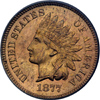 |
One of the Finest Known 1877 Cents. PCGS graded MS-66 Red. This is an outstanding gem example with vibrant luster and great strike. At present there are 5 examples graded by PCGS with none graded higher. The obverse is virtually mark free, while the reverse does show two light contact marks under the E in CENT and between the E in ONE and the wreath. There is also a mark hidden in the wreath at 3:00. Other areas of alternating luster are Mint caused. There are two planchet voids to the right of the E in ONE caused by a liquid, probably machine oil, on the planchet at the time of striking. There are light unobliterated planchet marks on the high points of the right wreath. Three or four light clash marks are visible above the O and E in ONE. These are transferred from the chin and last feather of the obverse portrait. The clashing and Mint made anomalies are not grade limiting. This example is an exquisite example and probably ranks as 3rd or 4th finest known.
All non-proof 1877 Indian cents are seen struck using one reverse die, which shows a shallow N in ONE. This is a reverse type used from the 1860's until 1869 and sporadically thereafter until 1873. This reverse die shows no die cracks, although 90% of this issue show the clashing described above. How could the entire mintage of 852,000 pieces have been struck with only one reverse? I do not have an answer. Mint records show 6 reverse dies being produced for regular coinage in 1877, but 4 were not used until 1878, leaving 2 reverse dies used for 1877. Where are the coins struck from the second die? Is that one of the proof dies? Either the actual mintage is even lower than the number customarily reported, or the entire batch of 1877's from a second die is missing.
The mintage of 1877's was an all time low for the series, not to be underproduced until the 1909 San Francisco Mint Indian Cent. It is true that the low mintage is due in part to a slowdown in the economy, which forced large quantities of older cents back into circulation. This caused the Mint to produce less new cents. However, this explanation oversimplifies the cause and effect. To get to the real reason of the scarcity of cents of this date we must go back to the Mint act of 1864, which gave a limited legal tender limit of only ten cents to the new bronze cent. No special legislative action was made to allow Banks to move the quantities of cents that accumulated in their vaults. The action needed to alleviate this problem came in the form of the Mint act of March 3, 1871, which required The Mint to redeem the older minor coins in any quantity. At first the coins, which in addition to bronze cents included older copper cents, half cents, copper-nickel cents, bronze two cent pieces, nickel three cents and nickel five cent pieces, were melted and recoined into new three and five cent nickels and bronze cents. By 1874, as less and less of the pre-1864 coinage was being redeemed it became obvious that the remaining bronze cents and nickel coinage could just be taken in and paid out without going through the recoinage process. The Mint then operated as a clearinghouse for the backlog of minor coins, reissuing them side by side with newly minted coins. Since the coins were already on the books from their original mintage, they were accounted for separately from the mintage of new coinage. With the surge of redemption in 1877, new coinage was cut off early in the year. Over 10 million cents were issued in 1877, but less than 1 million of them were new coins carrying that date. The rest of the issuance was made up of older coins.
Estimated Value $30,000-UP.
Includes Eagle Eye Photo Seal.
View details and enlarged photos
| Realized
$29,900 |
Lot 1116 |
|
1878 Indian Head Cent. PCGS graded Proof 65 Red. This is a very attractive example with moderately deep mirrors and outstanding surfaces. Starting in 1878 many things changed at the Mint. Proof production of minor coinage increased to two to three times the previous year's mintage. The actual mintage of minor proofs were now recorded with accuracy. The Mint's minor coin production was based more on expected demand than actual demand. The many unsold examples were sold in bulk to local coin dealers at or near face value. Also starting this year planchet production for minor coinage was shifted from the Mint to outside sources. The quality of proof coinage improved.
Estimated Value $800 - 1,000.
Includes Eagle Eye Photo Seal.
View details
| Realized
$978 |
Lot 1117 |
|
1879 Indian Head Cent. PCGS graded Proof 67 Red. An exquisite example with outstanding eye appeal commensurate with the grade given. Moderately deep mirrors flash in the light with unparalleled beauty. This date is more commonly found in higher grades than most other dates in the proof series. This would be a perfect date for a high quality type set.
Estimated Value $2,500 - 3,500.
Includes Eagle Eye Photo Seal.
View details
| Realized
$4,600 |
Lot 1118 |
|
1880 Indian Head Cent. PCGS graded Proof 67 Red. Another beautiful gem proof with moderately deep mirrors and nearly perfect surfaces. A common date in the proof series, if in fact any date can truly be called "common". The two 8's in the date show some punch breakage. The digit punches used this year show broken or partially missing elements to varying degrees. Many different dies were effected.
Estimated Value $2,500 - 3,500.
Includes Eagle Eye Photo Seal.
View details
| Realized
$5,060 |
Lot 1119 |
|
1881 Indian Head Cent. PCGS graded Proof 65 Red. A nearly flawless example with moderate mirrors and deep reddish color. A patch of lighter tone is evident on the neck and chin.
Estimated Value $600 - 800.
Includes Eagle Eye Photo Seal.
View details
| Realized
$1,093 |
Lot 1120 |
|
1882 Indian Head Cent. PCGS graded Proof 65 Red. Essentially flawless, possibly nicer than the grade implies. The mirrors are moderately deep on the obverse and a bit more muted on the reverse, perhaps the reason this did not grade higher.
Estimated Value $700 - 1,000.
Includes Eagle Eye Photo Seal.
View details
| Realized
$1,783 |
Lot 1121 |
|
1883 Indian Head Cent. PCGS graded Proof 66 Red. A really beautiful example with outstanding eye appeal. The mirrors are quite deep, but not quite to cameo status. It is essentially perfect, very high end for the grade. Full red gem proof Indian Cents for this year are very tough to find. Presently the PCGS population is 4 in PR-66RD and 1 in PR-67. This is curious since the mintage is one of the highest of the series. This situation also exists for the 1886 and 1888 issues which have an even higher mintage and are even rarer than this date in gem full red.
Estimated Value $2,000 - 2,500.
Includes Eagle Eye Photo Seal.
View details
| Realized
$4,140 |
Lot 1122 |
|
1883 Indian Head Cent. PCGS graded MS-66 Red. A really exciting variety with a bold misplaced digit (either an 8 or a 3) punched in the field above the denticles below the 83 in the date. Unknown to the numismatic community until 1995, this is a very rare and dramatic variety. Only a handful of examples have been found. This one is undoubtedly the finest known. This is fully struck with very early dies, probably one of first few struck. The details are knife sharp and the fields are prooflike with die striations indicative of a recently polished die. A real opportunity for the variety collector.
Estimated Value $1,500 - 2,000.
View details
| Realized
$3,450 |
Lot 1123 |
|
1884 Indian Head Cent. PCGS graded Proof 66 Red. Another sparkling beauty, a virtual twin to the 1883 just offered. Nearly flawless surfaces with deep mirrors although not quite cameo status. This is considered a common date and is one of the more available dates in this grade.
Estimated Value $1,000 - 1,500.
Includes Eagle Eye Photo Seal.
View details
| Realized
$2,875 |
|
|